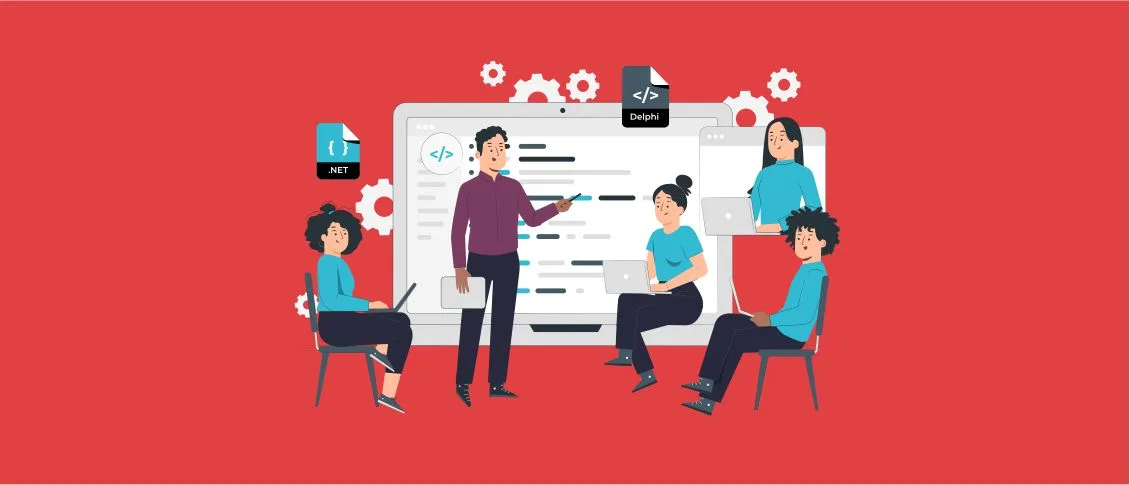Quite often, when companies see that their existing software doesn’t cope with the set tasks anymore, they start thinking about the necessity to replace it with a new product. Though in some cases, the development from scratch can be the best solution, it is definitely not the only one. If you find yourself in such a situation, one of the approaches that you should also consider is software migration. While there are different types of legacy software migration services, in this article, we’d like to talk about cloud migration and, namely, AWS cloud migration strategy.
Formulating an AWS Migration Strategy
Formulating a cloud application migration strategy involves careful planning and consideration of various factors to ensure a smooth migration of all infrastructure resources, such as data, services, and applications, to the cloud. An AWS cloud migration strategy is essential for both companies moving their legacy systems to the cloud for the first time and existing cloud users looking to optimize their investment.
To opt for the most appropriate AWS migration approach in your situation, we recommend you learn more about the so-called 6 R cloud migration types, or it’s even better to define AWS migration 7 Rs. The second classification presupposes a more detailed analysis of the existing AWS migration types.
AWS 7 Rs of migration
The choice of the AWS migration approach can significantly impact the benefits derived from the migration. By selecting a cloud application migration strategy that aligns with your business goals and technical requirements, you can maximize the potential benefits such as improved performance, enhanced functionality, scalability, and cost savings.
Rehosting
Rehosting is one of the AWS migration types. It involves moving an application or workload from its current environment to a new environment without making significant changes to the architecture or functionality. Rehosting focuses on moving existing infrastructure components, such as servers, databases, and middleware, to a new hosting environment, typically a cloud platform or virtualized infrastructure, with minimal changes.
Replatforming
Replatforming is a software migration strategy that involves making minimal changes to an application or workload during the migration process. It can also be viewed as a popular AWS cloud migration approach. Unlike rehosting, which aims to migrate existing infrastructure components to a new environment without significant changes, AWS replatform migration steps involve optimizing the application or workload to better take advantage of the capabilities and benefits of the target platform, typically a cloud environment.
Repurchasing
Repurchasing is a software migration strategy that involves replacing existing applications or systems with commercially available off-the-shelf software solutions. Instead of migrating or modifying existing software, organizations prefer to purchase new solutions that meet their requirements and objectives.
Re-architecting
As an application cloud migration strategy, re-architecting involves redesigning the architecture and infrastructure of an application to address limitations, improve scalability, enhance performance, or adopt new technologies. Unlike refactoring, which focuses on improving the internal quality of the codebase, this AWS cloud migration strategy may involve fundamental changes to the application’s architecture, such as adopting microservices, decoupling components, or migrating to a cloud-native architecture.
Retire
This cloud application migration strategy involves decommissioning or discontinuing an existing application, system, or component that is no longer needed or relevant to the organization’s operations. This approach aims to streamline the IT landscape, reduce maintenance costs, and eliminate redundancy by retiring obsolete or outdated software assets.
Retain
Retain is a software migration approach that includes keeping existing applications, systems, or components in their current state without making any changes or modifications. This strategy is typically chosen for software assets that are still serving a valuable purpose, meeting business needs, or are too costly or risky to migrate or retire at the present time.
Relocate
Relocate, as a migration strategy, presupposes moving an application, system, or component from one environment to another while maintaining its existing functionality and architecture. Unlike rehosting, which typically involves moving to a different infrastructure without significant changes, relocation may involve the introduction of some modifications to the application or its dependencies.
Roadmap for migrating to AWS (Amazon Web Services)
After considering the existing AWS migration strategies and choosing the most preferable one, you need to understand how to organize the entire process of the migration. The general plan will always stay the same regardless of the exact AWS migration approach that you have opted for.
Assessment and Planning:
- Evaluate your current IT landscape, including applications, data, infrastructure, and dependencies.
- Define your migration goals, such as cost reduction, scalability, agility, or compliance.
- Assess the readiness of your workloads for migration using AWS Migration Hub, AWS Discovery Service, or third-party assessment tools.
- Prioritize workloads based on factors like business criticality, complexity, and compatibility with cloud environments.
AWS Account Setup and Governance:
- Create AWS accounts and establish governance policies, security controls, and resource tagging strategies to ensure compliance and cost management.
- Define roles and permissions for team members involved in the migration process using AWS Identity and Access Management (IAM).
Network and Identity Setup:
- Design and configure network architecture using Amazon Virtual Private Cloud (VPC), subnets, route tables, and security groups.
- Set up connectivity options, such as VPN or Direct Connect, to establish secure connections between on-premises infrastructure and AWS.
- Implement identity and access management using AWS IAM to manage user identities, roles, and permissions.
Data Migration Strategy:
- Choose the appropriate data migration method based on workload requirements, data volume, and latency constraints (e.g., AWS Database Migration Service, AWS Snow Family, AWS DataSync).
- Develop data migration plans for databases, file systems, and other data repositories, ensuring data integrity, consistency, and security throughout the migration process.
Application Cloud Migration Strategy:
- Select the AWS migration approach (e.g., rehosting, replatforming, refactoring, repurchasing) based on workload characteristics, technical requirements, and business objectives.
- Use AWS Server Migration Service (SMS), AWS Migration Hub, or third-party migration tools to automate and streamline the migration of virtual machines, servers, and applications to AWS.
- Leverage AWS services like AWS Elastic Beanstalk, AWS Lambda, or AWS App Runner for deploying and managing containerized or serverless applications.
Testing and Validation:
- Develop a comprehensive testing plan covering functional testing, performance testing, security testing, and compliance validation.
- Use AWS services like AWS CloudFormation, AWS CodeDeploy, or AWS CodePipeline for automating testing, deployment, and validation processes.
- Conduct testing in staging environments to identify and address any issues or discrepancies before migrating to production.
Training and Documentation:
- Provide training to IT staff, developers, and end-users on AWS services, best practices, and operational procedures.
- Develop documentation, runbooks, and knowledge base articles to support ongoing maintenance, troubleshooting, and optimization of AWS resources.
Deployment and Rollout:
- Plan the migration timeline, including scheduling, downtime management, and communication with stakeholders.
- Execute the cloud application migration strategy plan according to the defined roadmap, closely monitoring progress and addressing any issues or concerns.
- Implement a phased rollout strategy to minimize disruption and ensure a smooth transition to the AWS Cloud environment.
Post-Migration Optimization:
- Monitor AWS resources and workloads using AWS CloudWatch, AWS Trusted Advisor, or third-party monitoring tools.
- Implement cost optimization strategies, such as rightsizing instances, leveraging Reserved Instances, or using AWS Cost Explorer for cost visibility and analysis.
- Continuously optimize performance, security, and scalability of AWS resources based on monitoring data and feedback from stakeholders.
Governance and Compliance:
- Implement governance controls and compliance frameworks, such as AWS Organizations, AWS Config, AWS Control Tower, and AWS Security Hub, to enforce security policies, compliance standards, and regulatory requirements.
- Conduct regular audits, security assessments, and compliance checks to ensure adherence to industry best practices and regulatory guidelines.
By following this roadmap, organizations can effectively plan, execute, and optimize their migration to AWS Cloud, which will enable them to leverage the scalability, reliability, and innovation offered by cloud computing to achieve their business objectives.
How to choose the right AWS migration strategy for your business
Choosing the right AWS cloud migration strategy for your business requires careful consideration of various factors, including your business objectives, technical requirements, existing infrastructure, and resource constraints.
Here’s a checklist that will help you choose the most suitable AWS cloud migration approach:
- Assess your current environment.
- Define your business goals and objectives.
- Understand AWS 7 Rs of migration strategies.
- Assess workload compatibility.
- Consider cost and resource constraints.
- Identify potential risks and challenges of different AWS migration types.
- Seek expert advice and guidance.
- Create a migration plan.
- Execute and iterate.
Migration to the cloud is a serious time- and effort-consuming process that is always associated with investments. That’s why, to avoid different kinds of risks, including financial losses, you should allocate enough time to consider various AWS cloud migration strategies and opt for the one that will help you achieve the set results as soon as possible.
If you do not have in-house specialists with relevant expertise who can conduct such migration, it is always better to rely on a professional partner like Softacom.
At our company, we have experience in working with businesses from many industries, which allows us to deeply understand the needs and demands of various markets. Our main goal is to help companies thrive and increase their profits by means of high-quality software solutions.















